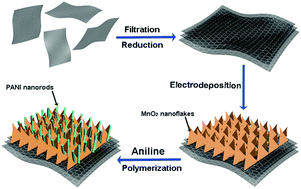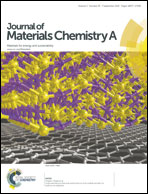MnO2 nanoflake/polyaniline nanorod hybrid nanostructures on graphene paper for high-performance flexible supercapacitor electrodes†
Abstract
A facile two-step strategy is adopted to construct a free-standing composite paper of MnO2 nanoflake/polyaniline (PANI) nanorod hybrid nanostructures on reduced graphene oxide (RGO) for flexible supercapacitor electrode application. MnO2 nanoflakes are first grown on RGO paper via an electrodeposition method, followed by assembly of PANI nanorods between MnO2 nanoflakes by in situ polymerization using camphorsulfonic acid as a dopant. The morphology and structure of the composite paper are characterized and the electrochemical properties are systematically investigated. The interconnected PANI nanorods deposited on the interlaced MnO2 nanoflakes have a length of ∼100 nm and a diameter of ∼30 nm, creating plenty of open porous structures which are beneficial for ion penetration into the electrode. The RGO/MnO2/PANI composite paper shows a large specific capacitance of 636.5 F g−1 at 1.0 A g−1 in 1.0 M Na2SO4 electrolyte and excellent cycling stability (85% capacitance retention after 104 cycles). The optimized composite structure with more electroactive sites, fast ion and electron transfer, and strong structural integrity endows the ternary composite paper electrode with outstanding electrochemical performance.


 Please wait while we load your content...
Please wait while we load your content...